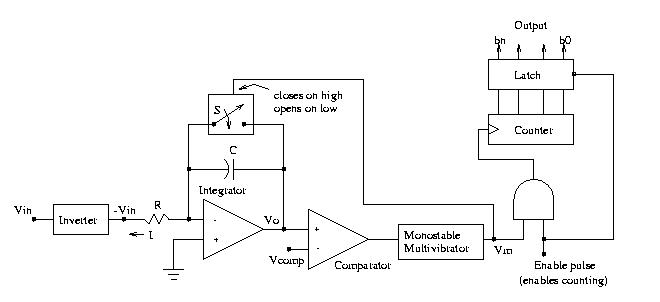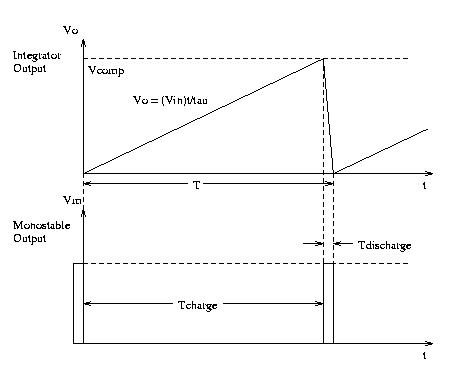Voltage to Frequency ADC


The voltage to frequency ADC works on the idea that the frequency of the
pulses of the monostable multivibrator in the above circuit, under the
condition that Tdischarge << Tcharge, is proportional to the input voltage
Vin. This is shown as follows:
I = Vin/R
Vo = Q/C


Vo = (Vin)t/(RC)
Substituting RC = tau:
Vo = (Vin)t/tau
The period of the monostable output pulses is:
T = Tcharge + Tdischarge
=> the frequency is:
f = 1/T = 1/( Tcharge + Tdischarge )
If Tdischarge << Tcharge then
f = 1/Tcharge (approximately)
From previously, Vo=(Vin)t/tau
=> Vcomp = (Vin)T/tau (see figure above)
and since Tdischarge << Tcharge
=> Vcomp = (Vin)Tcharge/tau (approximately)
Solving for Tcharge:
Tcharge = (Vcomp)tau/Vin
and since f = 1/Tcharge
=> f = Vin/(Vcomp(tau))
The voltage to be converted, Vin, must be inverted to -Vin at the input of the integrator, in order to produce a positive voltage at Vo. The -Vin voltage produces a current I, which charges the capacitor, increasing Vo until it equals Vcomp, triggering the comparator output to go high, thereby causing the monostable multivibrator to emit a pulse, at the beginning of which the switch, S, is closed, discharging the capacitor over the time Tdischarge. At the end of the pulse, the switch is once again opened, starting a new charge process. Each time the monostable multivibrator emits a pulse, the counter is incremented, so long as the enable pulse is high. Thus, while the enable pulse is high, the pulses emitted by the monostable multivibrator are counted, and when it goes low, the total is put through the latch to the output. This binary output number is proportional to the input voltage Vin, where the proportionality constant is 1/(Vcomp(RC)) = 1/(Vcomp(tau)).
